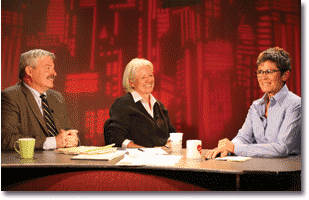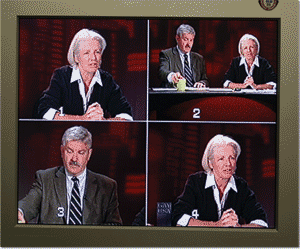Headliner: Ann Northrop '70
Ann Northrop ’70 has made a life out of making news. For seventeen years she did it as a journalist and television news producer in New York City. By 1989, though, Northrop was no longer producing news stories — she was making her own. Arrested in December of that year for protesting inside New York’s St. Patrick’s Cathedral with ACT UP, Northrop made international headlines.
ACT UP, the AIDS Coalition to Unleash Power, designed the protest to draw attention to the Catholic Church’s opposition to safer-sex education and legal abortion. Around 4,500 people turned out; 111 were arrested — 43, including Northrop, for lying down in the cathedral’s middle aisle and disrupting a service.
The St. Patrick’s arrest wasn’t Northrop’s first: that had happened in 1988, also with ACT UP, one of the groups generally considered most effective, in the early years of the AIDS crisis, at forcing the epidemic into the public consciousness. Northrop has, in fact, been arrested two dozen times, for work not only with ACT UP, but also with Queer Nation and the Lesbian Avengers. Being under arrest “turned out to be a lot easier than I had imagined,” she says. “Bring a couple of peanut-butter sandwiches and a trashy paperback and you can sit contentedly for hours in a holding cell.””
What distinguished the St. Patrick’s protest from others that Northrop had taken part in wasn’t the arrest; it was the increased attention given to it by the media and the special urgency of the criminal proceedings that followed. While other protests had attracted local and sometimes national coverage, the St. Patrick’s protest drew worldwide headlines. And while Northrop’s other arrests saw charges dismissed, the church arrest resulted in a trial televised on Court TV and a conviction on four misdemeanor counts. “ACT UP really upped the ante with the St. Patrick’s action,” she says. “We were confronting a major institution, and we hit a raw emotional nerve for a worldwide audience — which was exactly what we wanted to do."
Northrop was 39 years old at the time of her first arrest, older than most of her fellow ACT UP protesters. In its heyday, the group’s protests — part civil disobedience, part performance art — typically involved bold steps like interrupting trading on the floor of the New York Stock Exchange to draw attention

Long before ACT UP, though, Northrop had started on her own path of troublemaking. At Vassar, her sheltered, suburban upbringing began to crack under the influence of viewpoints — predominantly liberal — that she’d never before considered, from groups of people she’d never before encountered. The U.S. invasion of Cambodia and the shootings at Kent State University late in her senior year gave Northrop a chance to realize her own evolution. In fall 1966, when she entered Vassar, Northrop had favored the bombing of Hanoi; by spring 1970, at an all-college meeting designed to discuss the college’s response to national turmoil and the situation in Vietnam, she stood up and, semifacetiously, encouraged classmates to leave leafleting behind and head to Washington, DC, armed with machine guns, to find Secretary of Defense Melvin Laird.
Northrop describes most of her activism in the late ’60s and early ’70s as “mild, run-of-the-mill attendance at antiwar or feminist marches and protests.” Still, her growing radicalization throughout college compelled her personally and intellectually to pursue activism; it also helped that she thinks of it a lot like “play.” “I do it because it is fun and fascinating,” she says.
It’s only half-jokingly that Northrop, an avowed sports fan, suggests that perhaps “field hockey got me into activism.” There’s an energy to activism that drew her away from the “paralysis of doing nothing” and gave her a physical connection to the other people she united with at protests or in marches — “pumping each other full of a take-no-prisoners fervor,” as Bruni, in the Times article, described early ACT UP meetings, when as many as 700 people showed up. It was activism as team sport.
After graduating from Vassar, Northrop worked in print and broadcast journalism. She worked for the National Journal in Washington, DC, covering the federal government, and on the first issue of Ms., subsequently writing for that magazine, too. Her television work spanned writing and producing news, sports, and talk shows. But she witnessed what she considered to be the devolution of honest, accurate, and informative reporting, and the morning shows she’d worked for were poised to become the ultra-lightweight, undemanding chat shows that they are today. By 1987 she was fed up. To

She didn’t know what she’d do next, although she’s fond of joking that she’d have loved to have become a gym teacher — but she was “afraid of fulfilling the stereotype.” (Northrop has been out as a lesbian since 1976.) Teaching wasn’t so far off the mark, though. A friend suggested that Northrop check out the Hetrick-Martin Institute, a nonprofit organization that supports at-risk lesbian, gay, bisexual, transgender, and questioning youth in New York City. The institute had recently started a small school, the Harvey Milk High School, named after the slain gay San Francisco politician. They didn’t have an opening for a gym teacher — they didn’t even have a gym — but they were looking for an AIDS educator, to speak in schools and to community groups in the metropolitan area.
Northrop first encountered AIDS in 1981, back when it was still referred to either as the “gay cancer” or GRID, while working as a writer at ABC’s Good Morning, America. By 1982 she had moved to the CBS Morning News, and as a producer there she followed the growth of the AIDS epidemic for the next five years. Confident that her work covering AIDS in television news would be enough to give her some credibility for the Hetrick-Martin Institute job, she jumped at the offer. She teamed up with Andy Humm, also from the institute, speaking to tens of thousands of students and teachers in the city over the course of four years.
The team’s only rule for the students they spoke with was that there could be no censorship: no question was off limits. Rather than a gimmick to increase shock value, the rule was meant to send a clear signal that “we respected them enough to answer their questions, and they had to respect themselves enough to be open and honest,” Northrop says. More often than not Northrop and Humm found the students respectful and “hungry for the conversation. Our formula worked 100 percent of the time."
You can draw a straight line from Northrop’s work as an AIDS educator to her involvement with ACT UP. “I had no commitment to AIDS as an issue” before working as an AIDS educator, she says. “I just wanted a job that would make me happy on a daily basis. Once I started, I became totally radicalized around AIDS issues — and lesbian and gay issues.” Northrop came to ACT UP in March 1988, almost one year after its founding. “I fell in love in the first five minutes,” she says. “Here was a room full of energetic, iconoclastic individuals who I instantly identified with. It felt like home, and I never left."

She may have felt so comfortable there because, in many ways, it was more a return than a new beginning. “ACT UP took me back to my antiwar and feminist activism and gave me a chance to enlarge it,” she says. “It was clear to me that the class, race, and gender issues were still the same, and that the heart of the matter was about people in power being content with letting other people die."
Being an AIDS educator, which demanded visibility and frankness, emboldened Northrop to take an active, vocal role in ACT UP. For example, when gay and lesbian community leaders met with New York City mayoral hopeful Rudy Giuliani at a Third Avenue restaurant in 1989, ACT UP members were kept outside in the rain, picketing Giuliani’s opposition to the legal recognition of same-sex relationships and the granting of bereavement leave to city employees in same-sex or unmarried relationships, and his lack of a clear-cut plan to deal with AIDS in New York City. Cries of “bigot” and “shame” greeted the would-be mayor. Northrop made it inside the meeting and asked a visibly uncomfortable Giuliani, “Do you regard homosexuality as not a preference, not a choice, but natural and normal as a variation on the spectrum of human sexual orientation?” She was fearless, she says, feeling “entitled” by then to ask such questions directly and demand a straight answer.
Northrop stopped working as an AIDS educator in 1991, and her active involvement with ACT UP lessened after the late ’90s, even though she does remain a lifetime member. But in her current job as co-anchor of the weekly news program Gay USA, Northrop finds a perfect medium to combine her professional news experience with her activism.
Since 1996 Northrop has joined again with Andy Humm to anchor Gay USA, which endeavors to not just tell the news, but to explain it. “We help viewers to digest the information, to understand it in the context of history and looking forward,” she says. “It’s an admittedly unique perspective that makes us smarter about how we tell the news.”
Gay USA is on local-access TV in New York City but airs on the DISH Network and local cable systems nationally through Free Speech TV (which archives video of the show at its website; the audio portion of Gay USA is also distributed as a free podcast from the show’s own website and from iTunes). Ironically, Northrop points out, their audience is more often from the satellite broadcasts, which indicates that viewers are frequently tuning in from rural areas.
Hundreds have sent notes to Northrop and Humm to thank them for the broadcast, often admitting that Gay USA is the only place they can hear about lesbian, gay, bisexual, and transgender issues — and hear about them positively and in depth. The pair hopes to motivate their audience to get involved. Northrop says, “By being out on the air and openly activist, we hope to be role models for our audience and show them that they don’t have to be ashamed or scared, that they can be happier, safer, and more successful by standing up for themselves."
ACT UP founder Larry Kramer has said that “activism is fueled by anger”; but it’s more common to hear Northrop speak of laughter than of anger or despair when she reflects on her activist work. “I felt like I was making a difference on a daily basis, but I was having a great time, too,” she says. She advises others to “be selfish in your activism. Don’t do it because you feel like you have to; do it because it gives you joy.” That you manage to do some good for the world in the process is, in her opinion, “the gravy” of activism, not the reason for it.
Privilege is a word Northrop uses a lot to describe the chances she’s had to help usher in change and education — privilege, the honor to be on the cutting edge; and privilege, the education, class, and family background that has given her the support and confidence to believe she has a right to speak up. Northrop would be the first to admit that there are those who don’t have that second type of privilege — the time, the resources, the unwavering certainty that one has a right to be heard — to devote themselves, nearly full-time, to activism the way she has.
But, she insists, “Please don’t give me the excuse that you can’t do what I do.” She’s not suggesting that you do what she does, just to “find whatever it is that gives you joy, and do it."
—Micah Buis '02 is assistant editor of the journal Dædalus.
